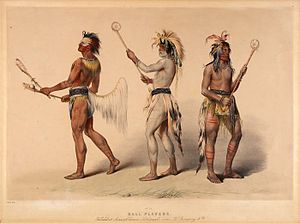Where did Lacrosse come from?
 Lacrosse has its origins in a tribal game played by eastern Woodlands Native Americans and by some Plains Indians tribes in what is now the United States of America and Canada. The game was extensively modified by European colonizers to North America to create its current collegiate and professional form.
Lacrosse has its origins in a tribal game played by eastern Woodlands Native Americans and by some Plains Indians tribes in what is now the United States of America and Canada. The game was extensively modified by European colonizers to North America to create its current collegiate and professional form.
Lacrosse has its origins in a tribal game played by eastern Woodlands Native Americans and by some Plains Indians tribes in what is now the United States of America and Canada. The game was extensively modified by European colonizers to North America to create its current collegiate and professional form. There were hundreds of native men playing a ball game with sticks. The game began with the ball being tossed into the air and the two sides rushing to catch it.
Because of the large number of players involved, these games generally tended to involve a huge mob of players swarming the ball and slowly moving across the field. Passing the ball was thought of as a trick, and it was seen as cowardly to dodge an opponent. years later lacrosse is still a popular sport played all over the world.
Traditional lacrosse games were sometimes major events that could last several days. As many as 100 to 1,000 men from opposing villages or tribes would participate. The games were played in open plains located between the two villages, and the goals could range from 500 yards (460 m) to 6 miles (9.7 km) apart.
Rules for these games were decided on the day before. Generally there was no out-of-bounds, and the ball could not be touched with the hands. The goals would be selected as large rocks or trees; in later years wooden posts were used. Playing time was often from sunup until sundown.
There were traditionally three areas of scoring on the stickball pole. There would be a mark, about chest high on the pole, which, when the ball hit above this mark, would award one point. Contact below that point was not scored. The top half of the pole, well above arms' reach, was usually worth two points when hit. The very top of the pole, usually embellished with a large figure of a fish or other sacred animal, was worth three points. In recreational games, scoring was loosely kept, most times by the audience or a few players. Games typically would reach around twenty points before concluding.
The game began with the ball being tossed into the air and the two sides rushing to catch it. Because of the large number of players involved, these games generally tended to involve a huge mob of players swarming the ball and slowly moving across the field. Passing the ball was thought of as a trick, and it was seen as cowardly to dodge an opponent.
The medicine men acted as coaches, and the women of the tribe were usually limited to serving refreshments to the players. There was also a women's version of lacrosse called amtahcha, which used much shorter sticks with larger heads.
Lacrosse traditionally had many different purposes. Some games were played to settle inter-tribal disputes. This function was essential to keeping the Six Nations of the Iroquois together. Lacrosse was also played to toughen young warriors for combat, for recreation, as part of festivals, and for the bets involved. Finally, lacrosse was played for religious reasons: "for the pleasure of the Creator," and to collectively pray for something.

